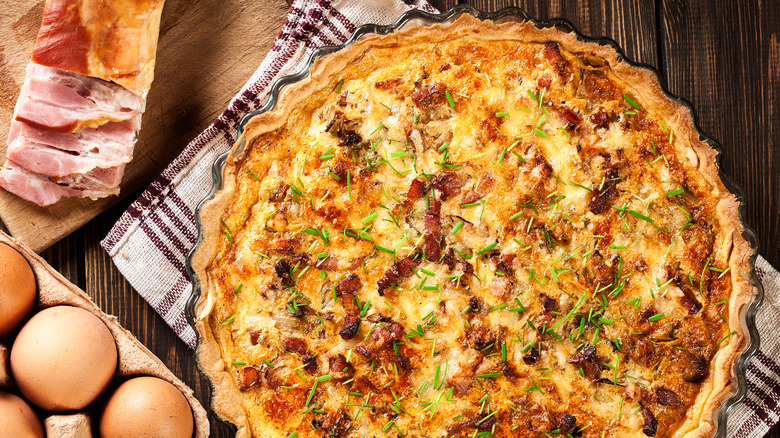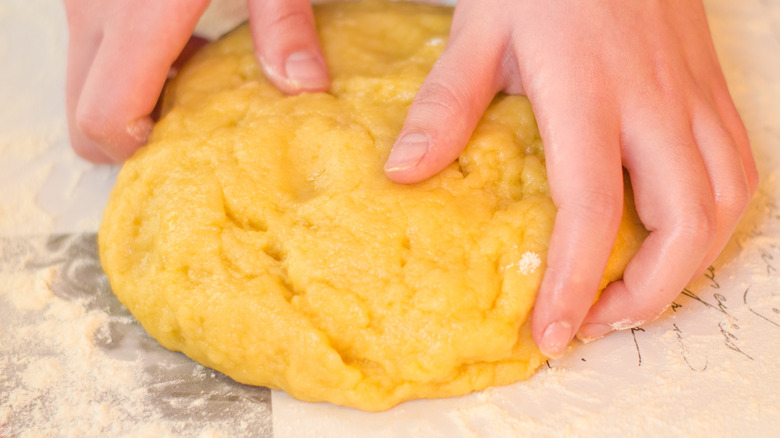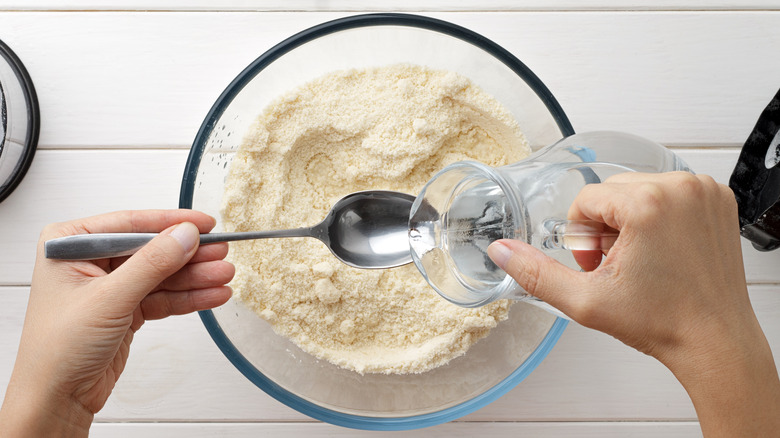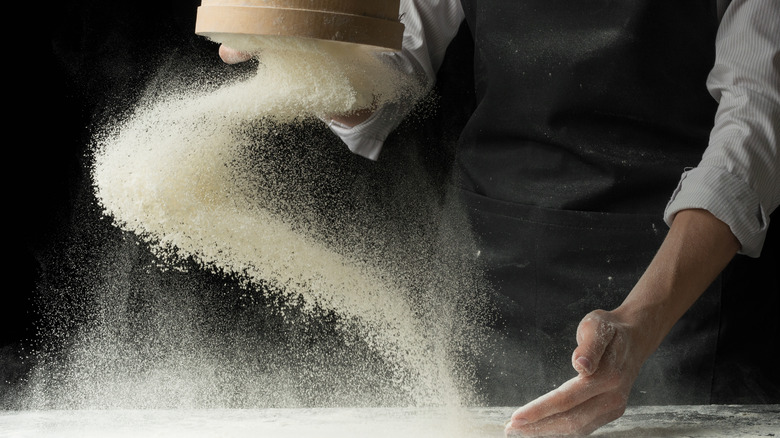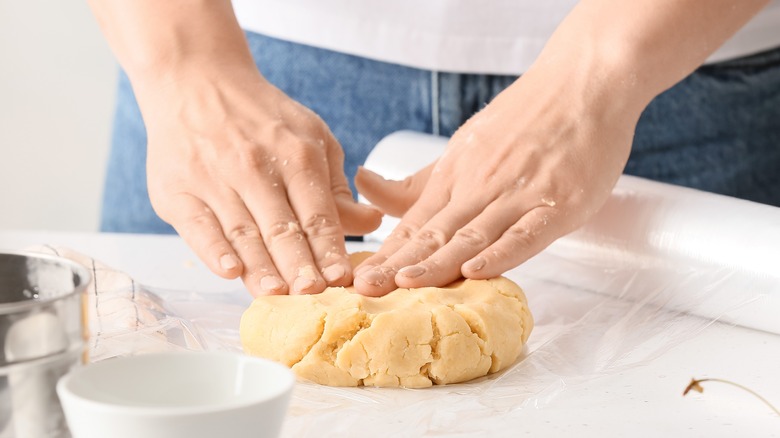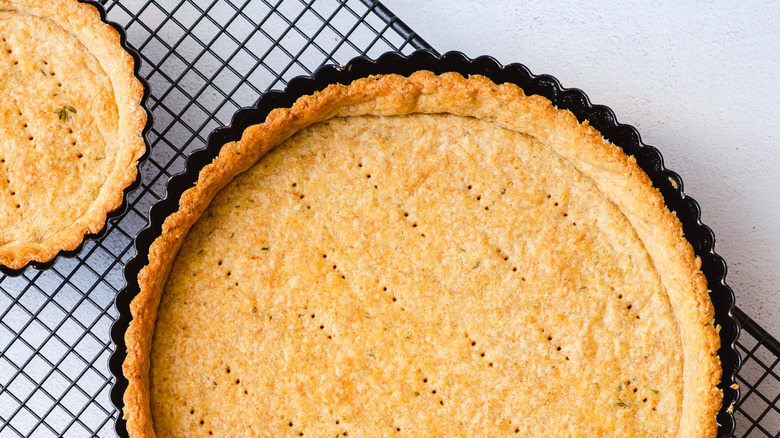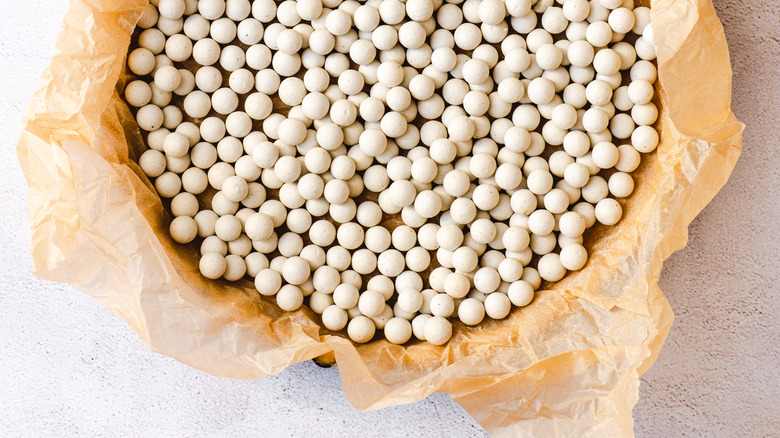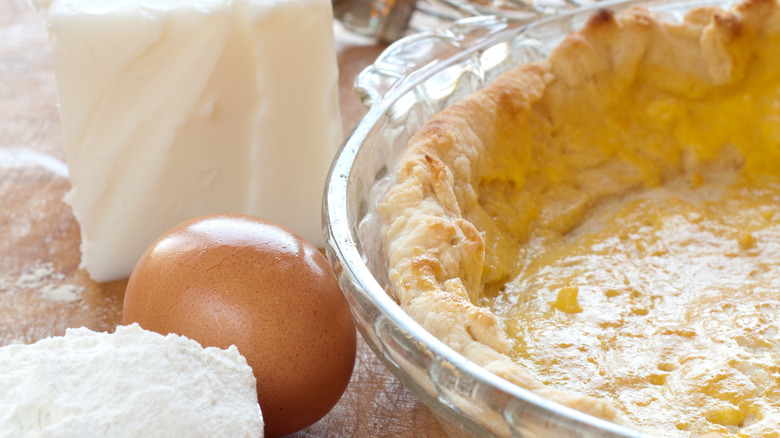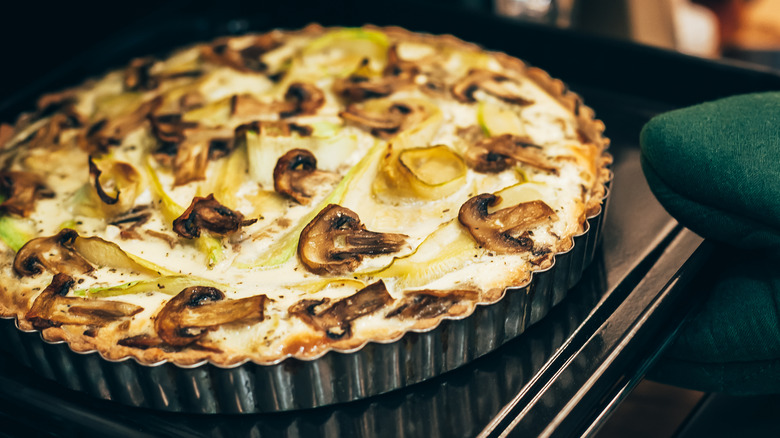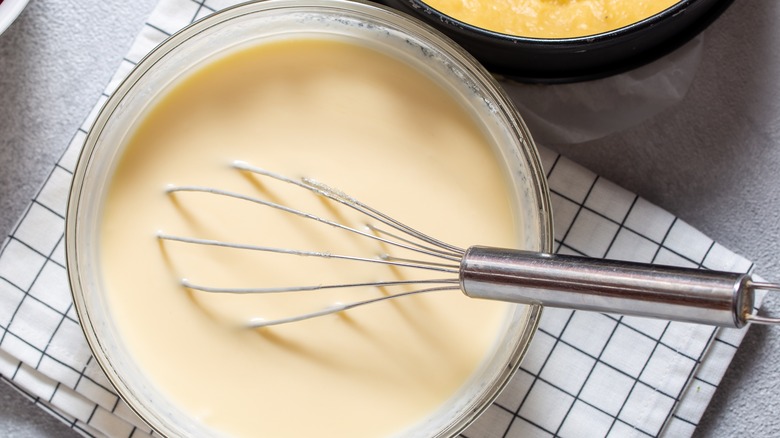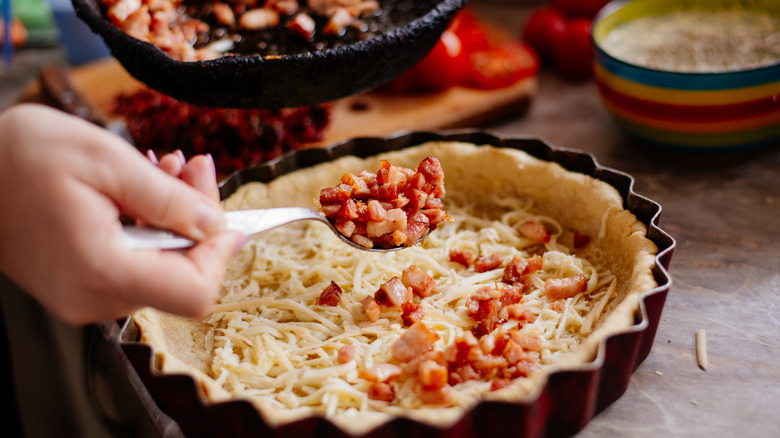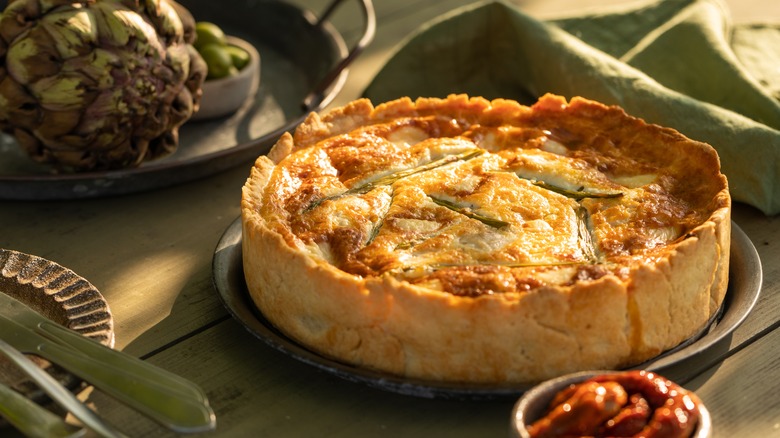Mistakes Everyone Makes When Preparing Quiche
We may receive a commission on purchases made from links.
A perfect quiche is the stuff of dreams. A firm, flaky crust topped with a rich, creamy filling speckled with bits of bacon or vegetables makes an ideal breakfast, a light lunch, or a great snack. Although the dish has questionable origins and probably a German-inspired name, it became popular as a classic French pastry. The list of regional quiche variations is seemingly endless, but quiche Lorraine is usually lauded as the original, or at least the best-known representative.
A perfectly baked quiche can become your go-to dish for any occasion, but poorly made versions could forever deter you from this practical savory pastry — which would be a shame. Although quiche is not an overly complicated dish, the preparation demands basic baking skills, especially if you want to make it from scratch. Once you decide it could be an ideal addition to your menu, you can follow several clever tips to avoid some common baking hiccups. Follow these instructions if you don't want to end up with an overcooked, scrambled custard trapped in a soggy, bland crust.
Overworking the dough
Quiche is a type of savory tart that can be quite versatile when it comes to fillings, but the pastry base does not leave much room for creativity. It must be perfectly executed, as it needs to be flaky but firm enough to hold the filling. Although puff pastry is sometimes used as a base, a basic shortcrust pastry is the most common option for a savory quiche. Shortcrust pastry generally combines flour, fat, liquid, and salt. It comes together quickly, and the most important advice is not to overwork it, according to BBC. Kneading helps the gluten develop, which makes your dough tough and could be the reason your pastry shrinks when it bakes.
Shortcrust pastry can be assembled in a food processor, using a pastry cutter, or simply mixing it by hand. If you choose to work with a food processor, you should be extra careful not to overmix the dough. Although the food processor might be more convenient, it will build the dough much faster, which might cause it to be overworked, according to The New York Times Cooking.
Putting too much liquid in the dough
To make the flaky shortcrust quiche base, you will need liquid to hold everything together. Traditionally, classic shortcrust pastry is made with water. Although the amount of liquid is usually modest, it is crucial, as the dough cannot be properly assembled without it.
The dough is made by rubbing the fat into the flour to create small, fat-coated pieces of flour. As explained in The Guardian, when the water is added, the layer of fat will prevent the water from totally hydrating the flour, and the dough will not develop gluten -– which is the desired quality of a great shortcrust pastry. This results in a soft, pliable dough that is easy to handle and bakes into a delicious base. Adding too much water will allow better gluten development, resulting in a gluten-rich, tough dough that is difficult to work with and bakes into a sturdy crust.
Adding water to the dough should be done carefully and in several stages, per Fine Cooking. A food processor might not be suitable, as the liquid might not distribute properly. If you go overboard with water, try adding more flour — but keep in mind that it will then require further kneading, which could result in overworked dough.
Using too much flour when rolling the dough
A common mistake people make when handling pastry is to add too much flour when rolling the dough. This is often the case with shortcrust pastry, which is soft and breaks easily. It may seem that heavily dusting your work surface would help you roll the dough without it cracking or sticking to the counter. However, adding too much flour at this stage could potentially ruin your dough. Any additional flour will integrate into the dough, messing with your flour-fat-water ratio and resulting in a firm dough that may not bake into a nice, flaky quiche crust.
If your dough is on the stickier side or doesn't hold well, instead of adding flour, it is best to place the disc-shaped dough between two layers of plastic wrap or parchment paper, as recommended by Cook's Illustrated. You can then easily roll the dough, as it will not stick to the paper or foil, and you can use the bottom sheet to transfer the dough to the pan. If these options are not available, try dusting your rolling pin instead of covering the whole work area with flour, per one baking blog's recommendation. This will give you better control of the amount of flour used.
Not refrigerating the dough
The golden pastry rule is to let your dough rest before rolling it. This also applies to the shortcrust pastry used for savory quiche bases. When your dough is assembled, it should be flattened into a disc and then wrapped with cling film. The disc shape will make the rolling easier, while the plastic covering protects the dough from taking on any undesired aromas. The dough should be allowed to rest for a minimum of 30 minutes, according to Tasting Table.
Refrigeration is essential, as it will firm up the fat in the dough, per The Guardian. If the pastry is correctly made and rolled, it will hold its shape and won't collapse during baking. Besides the form, refrigeration also makes for a more tender pastry crust, because the gluten loses tension as the dough chills.
Your dough can be refrigerated for 24 hours, but if you leave the rolling until the next day, make sure to pull out the dough earlier and leave it at room temperature for around half an hour beforehand. Otherwise, if it's too cold, the dough might be too tough and could break. Shortcrust pastry also freezes well, so you can make it in advance and pop it in the freezer. When you want to use the frozen dough, pull it out of the freezer the day before and thaw it in the fridge.
Skipping the blind baking step
Blind baking is a technique that is especially appreciated when dealing with shortcrust pastries or any type of pie crust. Essentially, it's the process of rolling the pastry shell and then prebaking it before adding the rest of the ingredients. It is also beneficial for any pie that does not require a baked filling.
The blind baking technique will provide a sturdier crust, which is crucial for savory or sweet pies with a creamy, liquid center, such as the custardy quiche filling. The raw crust easily absorbs liquid from the filling, but if the pastry shell is prebaked, the liquid will not be able to penetrate and soak the crust, and your quiche will not end up with a sad, soggy bottom. Instead, you should get a firm crust that holds the filling well.
The firm, pre-baked pastry shell also serves as a protective layer, which is handy for egg-based fillings, per Tasting Table. The well-baked crust will protect the custard from the heat, and your filling will likely stay creamy and moist.
Not using pie weights
If you decide to blind bake your quiche base, which you absolutely should, you will need to weigh down your pie crust during the prebaking step. Although pie crusts can be prebaked without pie weights, they are a great invention that can help you create the ideal quiche base. When the dough is rolled and fitted inside the pan, it is covered with a sheet of parchment paper or aluminum foil, which is then pressed down with pie weights. The pie weights will hold the crust in place — the bottom will not put puff up and it will bake evenly, while the edges won't sink to leave you with a flat quiche with no sides to hold your chosen filling.
Pie weights are usually round metal or ceramic balls created for this purpose. They are made from heat-resistant materials and should have enough weight to hold the bottom and the sides of your quiche base. Make sure to fill out the bottom and push the weights to the edges to hold the sides of the pastry crust.
If you can't find pie weights, there are several handy alternatives that you can use. Rice and beans are probably the best options — just make sure to cover your pie bottom with paper or foil so they don't get inside your crust.
Not brushing the crust with an egg white
Among our favorite secrets to attaining the perfect, golden-colored quiche crust with no cracks and enough stability to carry the filling involves the use of eggs. If the prebaked quiche crust cracked during baking, try brushing it with a lightly beaten egg white. Ideally, the crust should be taken straight from the oven while it's still piping hot, so that when the egg white is brushed on, the heat cooks and thickens the egg and tightly binds it to the pastry, closing any cracks to prevent possible leaks, per Cook's Illustrated.
Apart from helping to fill in any cracks, glazing your prebaked crust with a lightly beaten egg white also has an insulating effect. This is a great way to avoid a soggy quiche bottom. The egg white also serves as a protective layer that keeps the bottom crust firm and stable.
Baking the quiche for too long with the temperature set too high
You might have managed to build, roll, and bake your perfect quiche base and then top it with a silky-smooth custard, but the potential perils don't end there. When your quiche is oven-ready, carefully read the recipe and set your oven temperature correctly. Naturally, if the temperature is too low, it won't bake well, or it might take too long — but if the oven temperature is too high, the custard will cook too quickly, resulting in a "lumpy, chunky quiche."
Even if you bake it at the right temperature, don't leave the quiche in the oven for too long. You might even consider removing it from the oven before you think it is finished. As a typical quiche is usually round, the edges will cook first, but the heat will cause the quiche to continue cooking even after it's out of the oven. Take it out while the center has a slight jiggle and leave it at room temperature to completely set. You want your egg base on top of the quiche to thicken and set, but if it is baked too long, it will lead to syneresis, a process in which the protein is over-coagulated, causing your custard to curdle (via The Washington Post).
Using the wrong cream-to-egg ratio
The fundamental elements for a successful quiche are a well-baked pastry shell and a creamy filling. Getting the custard ratio right is paramount if you want to make the perfect quiche, per Tasting Table. You don't want to have a quiche with a runny center, but you also want to avoid having tough, crumbly custard covered in cracks that is too dry to eat and looks rather unappetizing. Classic quiche filling will be made with eggs and cream. The eggs should help your quiche set, while the cream provides a luscious, smooth texture. The eggs are the key element; if you add too many, the quiche will be tough, but the custard cannot properly set if there aren't enough eggs to hold it together.
According to chef Alice Waters, the suggested ideal measure is one egg to ½ cup of dairy. The classic cream (half-and-half) option can be replaced with milk, or you can also use a combination of the two. Another issue might be the size of the eggs. If you want to be absolutely sure you are using the proper ratio, it might be best to weigh your eggs. Thomas Keller (via CBS News) additionally recommends blending the custard to achieve a perfectly creamy and airy quiche center.
Using the wrong ingredients in the filling
Quiche fillings can be a great playground where you can customize them to your liking and show your creativity in the kitchen. A savory quiche can withstand many flavor combinations, and it adapts easily — best seen in the addition of cheese, which was not a part of the original version but is now somewhat of a standard ingredient. However, there are some guidelines you should follow if you want to make a great filling that has excellent structure and the perfect distribution of ingredients.
The most important advice is to make sure all the ingredients work well together. Although it might be tempting to add all your favorite ingredients at once, the flavors must be balanced, and it's vital to achieve the ideal ratio of add-ins and egg custard. The consistency of the additional ingredients inside the quiche is also critical. Avoid too many watery vegetables, as they might make your custard runny, and always try to pre-cook the ingredients before adding them to the mix (via Real Simple).
Making the quiche too thin
When it comes to baking, there is a whole variety of pans that you can use to bake a quiche. The classic 9-inch tart pan with a removable bottom is often marketed as a standard quiche pan. It is a relatively flat pan with a crimped edge that gives the quiche (or any savory tart) a distinctive, decorative look. This pan bakes a somewhat thin quiche that cannot hold much of the filling. If you want to add more ingredients, a deeper pan might be a better option.
Thomas Keller uses a ring mold, as he believes a quiche should be slightly thicker than what is typically made (via the Los Angeles Times), while David Lebovitz suggests using a cake pan to produce a slightly taller quiche that resembles those sold in French bakeries. Cake pans will give the quiche tall, straight edges and depth, resulting in a thicker pie that can hold more custard and many different fillings.
Not resting the quiche after baking
Quiche can be a luscious, rich dish, jam-packed with veggies, bacon, or ham, all neatly nestled inside a creamy custard. As the base is usually made with eggs and cream or milk, it needs some time to bake and always requires a resting period. Following the baking, when the quiche is removed from the oven, the heat will distribute throughout the tart and will continue to bake. Therefore, just as it is important to pull it out of the oven at the right point, it is also necessary to let it rest so it has enough time to set.
How long you rest your freshly baked quiche depends on the width and depth of your quiche pan. Quiches made in deep-dish cake pans will take longer to set, so be sure to give them enough time on the counter. Slicing it immediately after baking would let the heat and steam out, leaving the center too runny and increasing the chances of your perfectly assembled quiche collapsing. Thinner or wider tarts will take less time to chill, so adjust the resting time accordingly.
